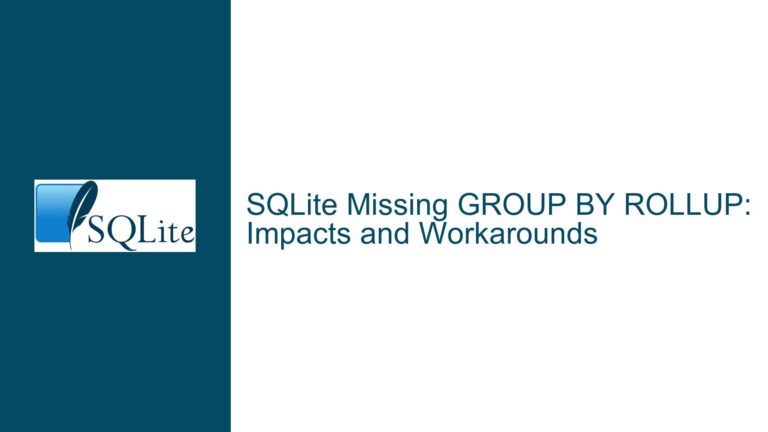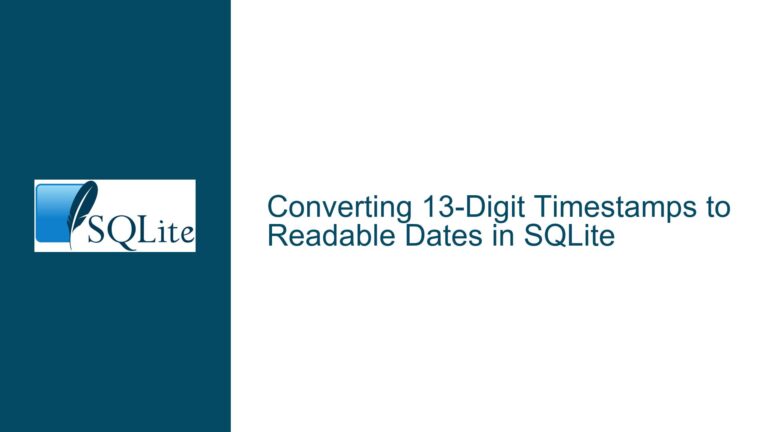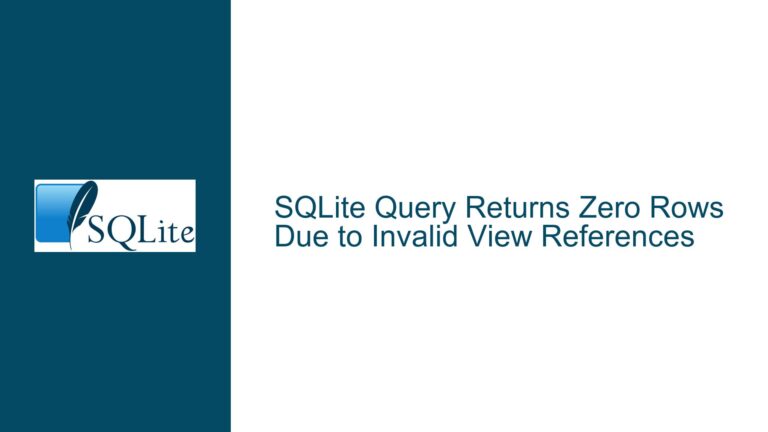Storing CLI-Generated JSON in SQLite and Reconstructing Original Data
Issue Overview: Inserting CLI-Generated JSON into a Table and Reconstructing Original Rows
A developer is attempting to use SQLite’s command-line interface (CLI) to generate JSON output from a query, store that JSON in a table, and later reconstruct the original query results from the stored JSON. The process involves two distinct challenges:
- Capturing CLI-generated JSON output into a table column.
- Parsing the stored JSON to recreate the original table rows.
The first challenge arises because the .mode json directive in the SQLite CLI is a formatting tool for human-readable output, not a mechanism for programmatically generating JSON within SQL. The second challenge involves leveraging SQLite’s JSON1 extension to parse the stored JSON array back into relational rows.
The developer has already created a table tblJSON with columns ref (a reference identifier) and json (to store the JSON text). They have also written CLI commands to output the results of SELECT * FROM employees as JSON to a file. The immediate goal is to load this JSON into tblJSON and then write a query that parses the JSON to reproduce the original employees table rows.
Possible Causes: Why Storing and Parsing CLI-Generated JSON Fails Initially
CLI Output Formatting vs. SQL Execution Context
The.mode jsoncommand in the SQLite CLI formats query results as JSON for display purposes only. This JSON output is not directly accessible within SQL statements executed in the same session. Attempting to insert the JSON output directly into a table using standard SQLINSERTstatements will fail because the CLI’s formatting commands operate outside the SQL execution context.File I/O Permissions and Path Resolution
When using the.oncecommand to write JSON output to a file (e.g.,e:/temp/json.json), the SQLite CLI must have write permissions for the specified directory. If the path is incorrect or permissions are insufficient, the file will not be created, leading to errors when attempting to read it later.JSON Structure Mismatch During Parsing
The JSON generated by the CLI is an array of objects, where each object represents a row from theemployeestable. For example:[ {"id":1,"name":"Alice"}, {"id":2,"name":"Bob"} ]Parsing this JSON to reconstruct the original rows requires understanding its structure. Misusing JSON functions like
json_eachorjson_extractwithout accounting for the array-of-objects format will result in incomplete or incorrect data.Missing or Incorrect Use of SQLite JSON Functions
SQLite’s JSON1 extension provides functions likejson(),json_array(),json_object(), andjson_each(). Failing to use these functions correctly—for example, attempting to parse a JSON array as a single object—will prevent successful reconstruction of the original rows.
Troubleshooting Steps, Solutions & Fixes: Storing and Querying CLI-Generated JSON
Step 1: Export CLI-Generated JSON to a File
Begin by ensuring the JSON output is correctly generated and saved to a file. Use the following CLI commands:
.mode json
.once e:/temp/json.json
SELECT * FROM employees;
Verify the file e:/temp/json.json exists and contains valid JSON. If the file is empty or malformed, check directory permissions and path syntax. On Windows, forward slashes (/) in paths are generally acceptable, but backslashes (\) may require escaping (e.g., e:\\temp\\json.json).
Step 2: Load the JSON File into the tblJSON Table
Use SQLite’s readfile() function (available in the CLI) to load the JSON text into the json column of tblJSON. First, ensure the tblJSON table has a row with ref = 'first':
INSERT OR IGNORE INTO tblJSON (ref, json) VALUES ('first', NULL);
Then update the json column with the contents of the file:
UPDATE tblJSON SET json = readfile('e:/temp/json.json') WHERE ref = 'first';
Verification:
SELECT length(json) FROM tblJSON WHERE ref = 'first';
This should return a non-zero value indicating the JSON text was loaded successfully.
Step 3: Parse the Stored JSON to Reconstruct Original Rows
To query the stored JSON and reproduce the original employees table rows, use json_each() to iterate over the JSON array and json_extract() to retrieve individual field values. Assume the employees table has columns id (INTEGER) and name (TEXT):
SELECT
json_extract(value, '$.id') AS id,
json_extract(value, '$.name') AS name
FROM tblJSON, json_each(tblJSON.json)
WHERE ref = 'first';
Breakdown:
json_each(tblJSON.json)expands the JSON array into a virtual table with avaluecolumn containing each JSON object.json_extract(value, '$.id')retrieves theidfield from each JSON object.
Generalized Approach for Unknown Schemas:
If the column names are unknown, use json_tree() to dynamically extract keys and values:
SELECT
fullkey AS column_path,
value AS column_value
FROM tblJSON, json_tree(tblJSON.json)
WHERE ref = 'first' AND type NOT IN ('array','object');
This returns all scalar values in the JSON structure, which can be filtered further based on the nested paths.
Step 4: Handle Edge Cases and Validation
Empty or Invalid JSON:
If thejsoncolumn isNULLor contains invalid JSON,json_each()will return no rows. Validate the JSON before parsing:SELECT json_valid(json) FROM tblJSON WHERE ref = 'first';If this returns
0, re-export the JSON from the CLI and reload it.Case Sensitivity in JSON Keys:
SQLite’s JSON functions are case-sensitive. If the CLI outputs keys in camelCase (e.g.,{"employeeId":1}), use the exact key name injson_extract:json_extract(value, '$.employeeId')Preserving Data Types:
JSON does not distinguish between integer and text types. Explicitly cast values if necessary:CAST(json_extract(value, '$.id') AS INTEGER) AS id
Alternative Approach: Avoiding Intermediate Files
To avoid writing to a file, chain two SQLite CLI instances using a pipe (Unix-like systems):
sqlite3 original.db "SELECT * FROM employees;" \
| sqlite3 target.db "INSERT INTO tblJSON (ref, json) VALUES ('first', readfile('/dev/stdin'));"
On Windows, use a named pipe or temporary file.
Final Solution Code
Export and Load JSON:
sqlite3 company.db ".mode json" ".once output.json" "SELECT * FROM employees;" ".exit" sqlite3 company.db "UPDATE tblJSON SET json = readfile('output.json') WHERE ref = 'first';"Query the JSON:
-- For known schema: SELECT json_extract(value, '$.id') AS id, json_extract(value, '$.name') AS name FROM tblJSON, json_each(tblJSON.json) WHERE ref = 'first'; -- For unknown schema: SELECT json_extract(value, '$.' || key) AS dynamic_value FROM tblJSON, json_each(tblJSON.json), json_each(json_each.value) WHERE ref = 'first';
By following these steps, developers can reliably store CLI-generated JSON in a table and reconstruct the original data using SQLite’s JSON functions.






